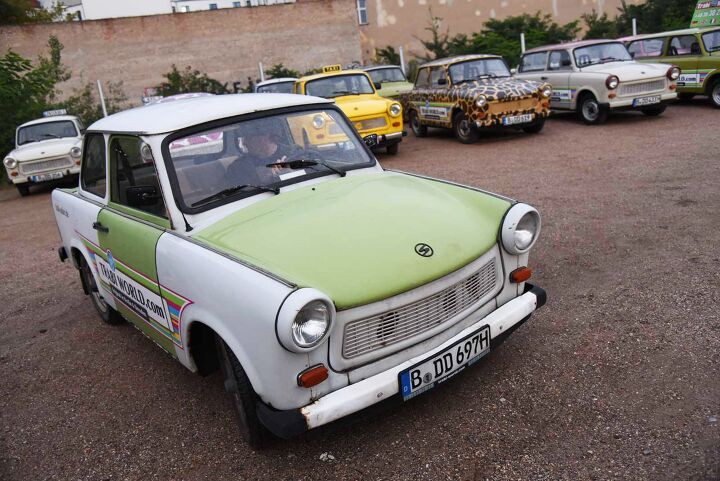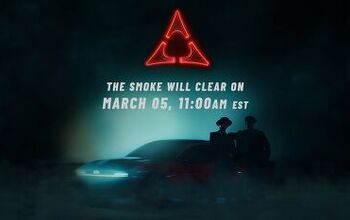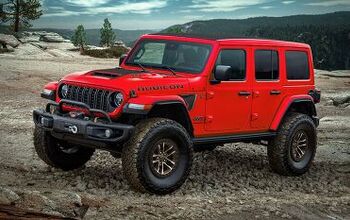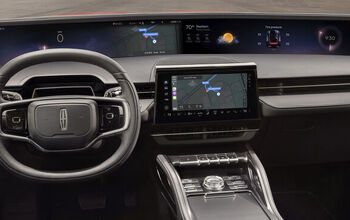Driving the Depressing, Crappy, Communist-Era Trabant Across Berlin

Every country has its own automotive icon, a singular vehicle that typifies the nation and people that built it.
For Americans, this car is undoubtedly the Ford Model T, a product that mobilized millions while simultaneously expanding horizons beyond the family farm. In Great Britain, this vehicle is unquestionably the BMC Mini. Across the channel, Citroen’s 2CV proudly brandishes France’s tri-color flag. Not to be forgotten, Italians have their Cinquecento, the diminutive Fiat 500.
Of course, Germany’s iconic automobile is the irrepressible Volkswagen Beetle, an air-cooled marvel of Nazi-sponsored mass production. But the Käfer is only half of this story, literally.
Remember, from 1949 until 1990, there were actually two Germanys separated by the Cold War’s Iron Curtain. Obscured by this ferrous drape was another famous automobile, a darling of its day, at least within Warsaw Pact countries.
Trabi Safari
The Trabant is an ugly little mutt of a machine that was designed to mobilize East Germans with affordable and reliable personal transportation. In English, its name means “satellite,” a self-congratulatory nod to the Soviet Union’s Sputnik program and perhaps a subconscious reference to how high engineers were while developing it. This is a car that’s every bit as crude as its pedigree suggests.
Against all odds, I got to drive one of these comically peculiar vehicles during my recent vacation in Germany following the Frankfurt Motor Show. A native buddy of mine and tour guide during this trip reserved slots for us on the “Trabi Safari,” a Berlin tourist attraction that’s on par with seeing Checkpoint Charlie and eating currywurst. It’s something that should be experienced by any gearhead with an appreciation for the weird.
And really, is there a better way to take in this European capital than through the oil-mottled glass of a communist-era automotive relic? I can’t think of any.
Trabant Basics
In one form or another, Trabants were produced from the late 1950s until the twilight of the ‘80s. They featured composite body panels and space-saving front-wheel drive. Talk about being ahead of their time! Unfortunately, those major exterior parts were made of plastic reinforced with cotton scraps or other fibers. This wasn’t an early attempt to be environmentally responsible; it was a move borne out of necessity because they didn’t have enough steel.
A glance under the Trabant’s Bakelite hood reveals something even more depressing. These cars are powered by a tiny two-cylinder, two-stroke engine because remember, only capitalist pigs need more moving parts and greater combustion complexity. Otto cycle? That’s overly decadent!
Supposedly the last production version of the Trabant featured a burly 26 horsepower, enough to propel the 1,100-pound car to 62 miles an hour in just 21 seconds. Trust me, you’ve never experienced a more exhilarating third of a minute in your lifetime!
The Drive
As an automotive journalist, I’ve tested a lot of different vehicles. Plenty of them have been great and a few not so much. But even the worst car I’ve ever sampled is far superior to the lowly Trabant.
At idle, the entire vehicle shook like an earthquake. At first, I thought something had catastrophically failed, but that wasn’t the case. This is not to say there’s a little un-attenuated NVH, oh no. The car *literally* trembles like a 9.0 on the Richter Scale. Simply put, it’s unbelievably coarse, imitating some sort of mining equipment thrashing away. Rev it up and the tiny two-stroke smoothes out marginally, but it’s still a festival of racket and harshness.
The car’s four-speed manual transmission is controlled by a stubby lever sprouting out of the steering column. It provides a rough approximation of gear selection, though it’s easy to get lost in the maze of gates as my buddy found out while driving, inadvertently jamming it into reverse while underway. Yeah, that mistake made a lot of really bad noises, though surprisingly it didn’t grenade the transmission.
Getting underway in the Trabant was a bit challenging because the car has zero torque; it’s almost like driving a Honda. Copious revs are required to get things moving, especially with three people on board. Fortunately, the clutch take-up is forgiving and the car’s unboosted steering easy to use, even at low speed.
As you might expect, acceleration is, at best, leisurely, at worst, catastrophically lethargic. This is probably the slowest vehicle I’ve ever driven and I own a 1936 Ford with just 100 horses on tap. With a complete lack of low-range torque, the car needs to be mercilessly revved to generate any sort of forward movement. During the climb to redline, which brings to mind an expedition up Mount Everest because it takes so long, the engine starts to develop a glimmer of power but then, half a second later, it’s time to upshift and start the waiting game all over again.
One particularly ironic aspect of this driving experience was the “No Smoking” placard inside. The car’s two-stroke engine emits more pollution than coal-seam fire. Its tiny tailpipe, which is scarcely larger in diameter than a penny, vomits out an endless stream of wispy-blue haze. This noxious ether penetrates the Trabant’s haphazardly sealed passenger compartment like an invading army violating a weaker nation’s defenseless frontier.
The tour guide leading this conga line was in constant radio communication with every member of our convoy during the safari, pointing out important sites and sharing historical anecdotes about the German capital, none of which I remember or frankly even heard; all of my limited capacity was expended trying to not kill myself or anyone else. Rush-hour traffic, rainy weather and suicidal cyclists were but a few of Berlin’s on-road hazards.
Conclusion: Big Fun in a Tiny Package
If you ever find yourself in Berlin the Trabi Safari is an attraction you’d be wise to check out. It’s a lot of fun and pretty reasonably priced. Who needs to see anther foreign embassy, museum or empty space where some wall once stood? Go drive a Trabant, a car so awful it’s awesome!
Check out our Car Reviews Section

Born and raised in metro Detroit, Craig was steeped in mechanics from childhood. He feels as much at home with a wrench or welding gun in his hand as he does behind the wheel or in front of a camera. Putting his Bachelor's Degree in Journalism to good use, he's always pumping out videos, reviews, and features for AutoGuide.com. When the workday is over, he can be found out driving his fully restored 1936 Ford V8 sedan. Craig has covered the automotive industry full time for more than 10 years and is a member of the Automotive Press Association (APA) and Midwest Automotive Media Association (MAMA).
More by Craig Cole

























































Comments
Join the conversation
Yeah, Yet That Crappy Car Can Survive A Moose Test. The Earlier MERCEDES A1 Could Not. Go Figure.
Referring to the Volkswagen Beetle as "an air-cooled marvel of Nazi-sponsored mass production" is incorrect. While the German government under Hitler did indeed build the first VW factory (the one at Wolfsburg), as well as fund Dr. Ferdinand Porsche's efforts to design and test the Beetle's prototype, not a single German civilian was able to purchase a Bug while the Third Reich was in power. The factory was completed in early 1940, right after World War II started, and it was used for wartime production - aircraft parts, weapons, and the military versions of the Volkswagen: the Kubelwagen (literally "Bucket Car"); and the Schwimmwagen ("Floating Car") amphibious vehicle. The VW plant manufactured over 55,000 Kubelwagens alone during the war. Volkswagen didn't begin building regular Beetles for civilians until after Hitler's regime fell in 1945. Perhaps a better description of the Beetle would be "an air-cooled marvel of German engineering and mass-production", since Dr. Porsche was definitely not a Nazi. He turned to the government for help in building his car only after the entire German auto industry had turned him down. Plus, don't forget: in 1934 Hitler had only been in power a year, and had yet to show his true colors. No one - in Germany or abroad - had any idea what kind of a tyrannical war-monger he'd turn out to be.